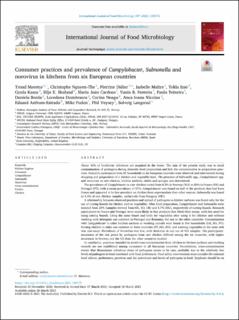| dc.description.abstract | About 40% of foodborne infections are acquired in the home. The aim of the present study was to track contamination of pathogens during domestic food preparation and link the contamination to preparation practices. Research participants from 87 households in six European countries were observed and interviewed during shopping and preparation of a chicken and vegetable meal. The presence of Salmonella spp., Campylobacter spp. and norovirus on raw chicken, kitchen surfaces, cloths and sponges was determined. The prevalence of Campylobacter on raw chicken varied from 8.3% in Norway (NO) to 80% in France (FR) and Portugal (PT), with a mean prevalence of 57%. Campylobacter was found on half of the products that had been frozen and appeared to be less prevalent on chicken from supermarkets than other sources. Salmonella was found in 8.6% of raw chicken samples, exclusively from Hungary (HU). A relationship between observed practices and spread of pathogens to kitchen surfaces was found only for the use of cutting boards for chicken and/or vegetables. After food preparation, Campylobacter and Salmonella were isolated from 23% (samples derived from HU, RO, UK) and 8.7% (HU), respectively of cutting boards. Research participants in France and Portugal were more likely to buy products that fitted their recipe, with less need for using cutting boards. Using the same board and knife for vegetables after using it for chicken and without washing with detergent was common in Portugal and Romania, but not in the other countries. Contamination with Campylobacter to other kitchen surfaces or washing utensils were found in five households (UK, RO, PT). Rinsing chicken in sinks was common in three countries (PT, HU, RO), and washing vegetables in the same sink was also usual. Prevalence of Norovirus was low, with detection in one out of 451 samples. The participants' awareness of the risk posed by pathogens from raw chicken differed among the six countries, with higher awareness in Norway and the UK than the other countries studied. In conclusion, practices intended to avoid cross-contamination from chicken to kitchen surfaces and washing utensils are not established among consumers in all European countries. Nevertheless, cross-contamination events that disseminate infectious doses of pathogens seems to be rare, probably due to the relatively low levels of pathogens in food combined with food preferences. Food safety interventions must consider the national food culture, preferences, practices and the prevalence and levels of pathogens in food. Emphasis should be on providing and promoting chicken products with lower risk (prevalence of pathogens, ready-to-cook) and safe use of cutting boards. | |
